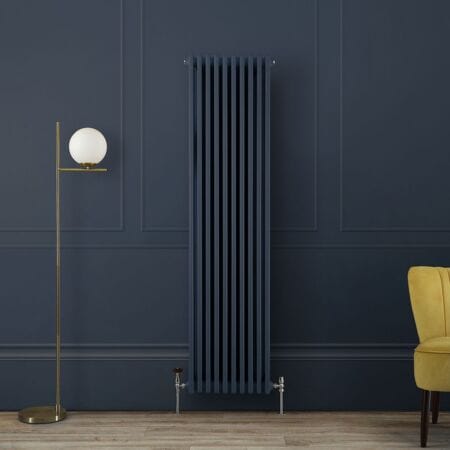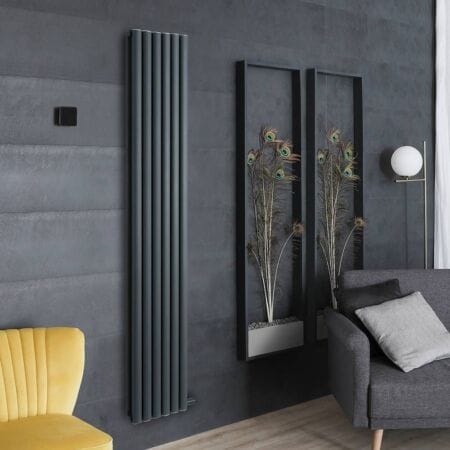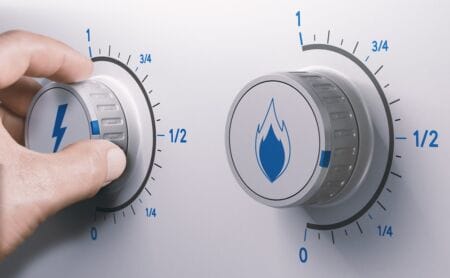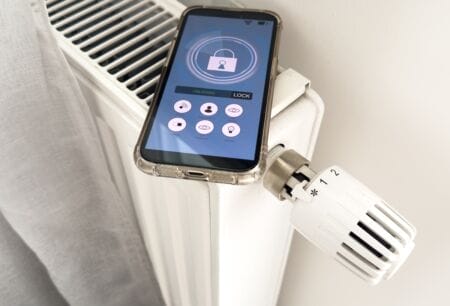Contents
ToggleWhat we'll cover...
Which energy efficient heating measures to consider to considerably cut your carbon footprint.
Best heating practices for lower emissions and energy bills
Let’s be honest – most of us didn’t lie awake at night worrying about our boiler’s environmental credentials back in the day. We just wanted it to work, preferably without sounding like it was about to take off.
But the times, they are a-changin’.
As climate awareness has grown, so has the realisation that our beloved home heating setups – the ones we rely on for cosy nights and shower-steam saunas – are also some of the biggest culprits in pumping CO₂ into the atmosphere, and how to reduce your carbon footprint has become somewhat of a hot topic if you’ll excuse the pun.
The good news? You don’t need to install a wind turbine in your garden or move to a Hobbit-style passive house to start making a difference. Whether you’re a renter, a renovator or just someone with cold feet and a conscience, there are smart, simple, and surprisingly satisfying ways to slash your heating emissions and reduce your carbon footprint aligned with the use of energy efficient radiators.
Why heating is one of the biggest contributors to household carbon emissions
Heating may not get the same headlines as plastic straws or long-haul flights, but when it comes to household emissions, it’s not the greatest surprise that it’s the real heavyweight.
According to UK government figures, space and water heating accounts for around 60% of domestic energy use. That’s right – six in 10 kilowatts you pay for are going straight into warming your home. And most of that energy is generated by gas boilers which, while efficient at supplying home radiators in a “gets-the-job-done” way, still chuck out CO₂ like it’s going out of fashion (spoiler: it very much is).
Why the fuss?
- Gas is a fossil fuel: No matter how efficient your boiler is, it’s burning something that took millions of years to form and a few hours to waste.
- Heat loss is real: Poorly insulated homes lose heat faster than a cup of tea in January. There’s more detail in our guide on how to make your home more energy efficient.
- Set-and-forget heating habits mean many homes are running heating unnecessarily, like warming the house while you’re on holiday on the other side of the world.
Every unnecessary blast of heat is a hammer blow to any bid to reduce your carbon footprint – and enhances your bills in turn. So if you’ve ever left the heating on for the dog while you’re at work, it might be time to reconsider, and take note of these handy energy efficient heating habits too.
Switching to energy efficient radiators: What you need to know
Your radiators might not seem like the problem – but if they’ve been clanking away since the 80s, chances are they’re not doing you (or the planet) any favours, and a designer radiator upgrade might be required to help you reduce your carbon footprint.
Our guide, is it time to replace your old radiators?, features pointers on what to look out for to decide if you need to make the switch.
What's wrong with older radiators?
- They take forever to warm up
- They’re often poorly placed (behind sofas, curtains, or “where the draught is strongest”). Our guide on where to position a radiator can help
- They give off heat unevenly – hot at the top, cold at the bottom, emotional damage in the middle
Why go energy efficient?
- Aluminium radiators heat up faster and retain warmth more evenly
- Electric radiators with digital thermostats let you fine-tune heating per room — no more blanket-heating the whole house
- Zonal heating compatibility means you can customise your comfort while cutting down on waste
Oh, and the newer models look far sleeker. So if you’re stuck with a rusting beige beast that’s practically a museum piece, now’s the time for a heating refresh. Our guide, Can designer radiators be energy efficient?, offers further insight.
The role of smart heating controls in reducing energy waste
No offence to the old-school dial thermostat, but your heating deserves a bit more nuance than “on”, “off” and “somewhere in the middle depending on whether you remembered to twist it.”
Enter: smart heating controls – your secret weapon in reducing energy waste without sacrificing a single degree of comfort.
What makes them so smart?
- Learning habits: They pick up on when you’re usually home and warm things up accordingly for optimal efficiency.
- Remote access: Forgot to turn off the heating before a weekend away? No worries. Do it from the beach. Or the bar. Or bed.
- Room-by-room control: No more heating the guest bedroom that gets used once a year (usually by a relative who prefers it cold anyway).
- Geofencing: Your heating knows when you’ve left the house and turns itself off. It’s like house-sitting, minus the awkward fridge snooping.
The result? A sustainable heating system with less energy used, fewer emissions released, and a sense of smug eco-satisfaction. Discover more on how smart heating can reduce your carbon footprint, and much more, in our ultimate guide to smart home heating controls.
How to pair insulation upgrades with efficient heating
Upgrading your heating system without tackling insulation is like buying a new kettle and then boiling water with the lid off. You can do it, but it’s not exactly the height of efficiency.
Quick insulation wins:
- Draught-proof doors and windows – because no one likes heating the street
- Radiator reflector panels – a tinfoil-style glow-up with actual benefits
- Thicker curtains and thermal blinds – chic and snug? Yes please
Bigger moves for bigger gains:
- Loft insulation – hot air rises… and escapes through your uninsulated roof
- Cavity wall insulation – like a fleece jacket for your home’s walls
- Underfloor insulation – ideal if you’ve ever wondered why your toes are still cold even when the heating’s on. Shop underfloor heating kits here.
A well-insulated home holds onto its heat like a pensioner holds onto a cup of tea. And that’s good news for both the climate and your gas bill.
Renewable energy and its role in the future of home heating
If the goal is to reduce your carbon footprint, ditching fossil fuels entirely is the gold standard. And thanks to modern tech, renewable heating options are now more accessible than ever.
The main options:
- Air source heat pumps – Pull warmth from the air, even when it’s freezing. Science! Read our ultimate guide to air source heat pumps to find out more about them.
- Ground source heat pumps – Use buried pipes to capture consistent underground heat.
- Solar thermal systems – Harness the sun to heat your water (yes, even in Britain — just give it time).
- Biomass boilers – Burn sustainably-sourced wood pellets with super-low emissions.
Most of these systems pair beautifully with smart controls and work wonders in well-insulated homes. They also come with a warm, fuzzy feeling that’s not just from the radiator.
Want help picking the right one? Explore our article, eco heating – what are the options?
Shop the look: The best products to lower your carbon footprint
It’s not all talk – here’s where the magic happens. The products below will help you take your heating game from “gas-guzzling guilt” to “eco-chic efficiency” in no time, and help you achieve the ultimate aim to reduce your carbon footprint.
Whether you’re starting small or going full Greta, there’s a product to help you heat smarter and greener.
Lower your carbon footprint with BestHeating
In the grand scheme of sustainability, heating your home is one of the most impactful places to start. It’s also one of the easiest to get spectacularly wrong – unless, of course, you’ve got the right knowledge and kit.
From smart thermostats to eco-friendly plug in electric radiators, reflector panels to renewable tech, there’s no shortage of ways to shrink your carbon footprint without sacrificing the creature comforts we all love.
And if you’re working with a compact space, our guide on eco-friendly heating for small homes could have just the ticket.
So go on, take the plunge. Ditch the draughts. Embrace the gadgets. And make your home a little warmer, and the planet a little cooler.
We’d love to see what sustainable upgrades you make, so let us know in the comments below, or reach out to us on Instagram, Facebook or X.
John is a Research Specialist for the Best Heating Advice Centre, where for over nine years he has dedicated himself to demystifying home heating for our customers. He specialises in creating clear, data-driven guides and how-to articles by collaborating directly with our team of certified heating experts and product engineers.
His work, built on a foundation of journalistic research, has helped millions of readers make confident and informed decisions about their home heating. When he’s not breaking down the heat output differentials from radiators to heated towel rails, John fancies himself as a fine football and music connoisseur.







